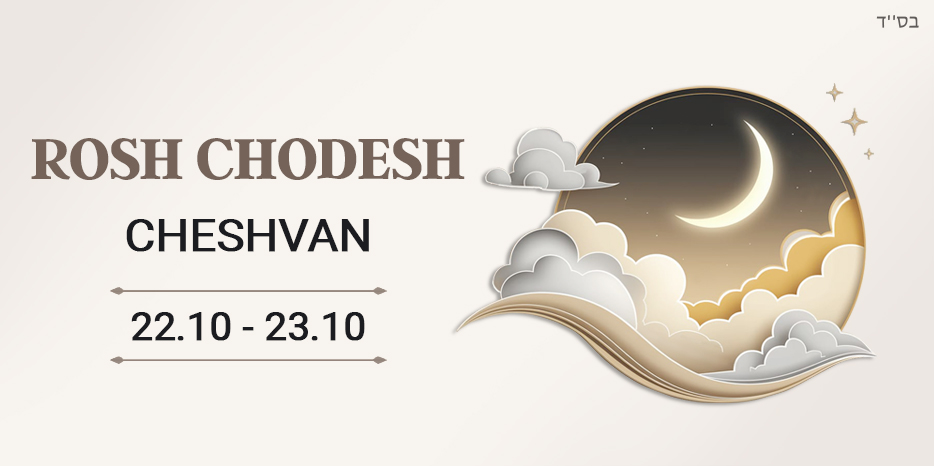After the tumultuous and holy days of the month of Tishrei comes Rosh Chodesh Cheshvan – a time when the soul of the Jewish people seems to take a breath. This new moon marks the transition from the spiritual peak of the holidays to weekdays, which require no less holiness. The month of Marcheshvan has no holidays commanded to us by the Torah. Rosh Chodesh Cheshvan is celebrated for two days – the first day falls on the 30th of Tishrei, and the second on the 1st of Cheshvan. This custom is connected to the fact that Tishrei is a full month (30 days).
The sages taught that the Mussaf prayer on Rosh Chodesh Cheshvan is read only from the prayer book, not by heart.
“Torah portions are not recited from memory” (Halakha).
Why specifically Cheshvan?
Because the Mussaf of this day is read after a two-month break – since on Rosh Hashanah the new moon is not mentioned. Therefore, Jews fear making even a single mistake in the sacred text.
“The words of Torah should be fresh in your mouth every day” (Talmud, Tractate Eruvin 54a).
Cheshvan is the eighth month counting from Nisan and the second from Tishrei.
In the Tanakh, it is called Bul:
“In the eleventh year, in the month of Bul – that is the eighth month – he completed the construction of the Temple” (Kings I, 6:38).
The word Bul means “withering” – the grass dries up, and livestock begin to be fed hay.
According to another interpretation, it is related to the word Yevul – harvest, for in Cheshvan the sowing season begins.
And also – to the word Mabul (Flood): it was in this month that the rains of the Flood began, flooding the earth in the times of Noah.
The Midrash states:
“Since the Flood began in the month of Cheshvan, it will remain rainy forever.”
In Jewish tradition, it is believed that the Great Flood began in the month of Cheshvan (or Marcheshvan) on the 17th day and ended on the 27th day of the same month a year later. Therefore, the month received the name “Marcheshvan,” which means “bitter Cheshvan,” as this period is associated with punishment for sins and sorrow over the calamities that befell Israel.
Why is Cheshvan called “Marcheshvan”?
After returning from Babylon, Jews began to call this month Marcheshvan.
The word “mar” means “bitterness” – for there is not a single holiday in this month.
The Midrash offers another explanation: “The bitterness of Cheshvan will be turned to joy – in the future, the Almighty will give it a holiday” (Yalkut Shimoni).
The month of Cheshvan holds pain:
The Flood began in this month.
In Marcheshvan, Jeroboam introduced idolatry.
In Marcheshvan, the Babylonians killed the sons of King Zedekiah.
But in each of these events, there is a hint of purification, of return to G-d. For from rains, life is born.
It was in the month of Cheshvan that King Solomon completed the construction of the Temple.
But its dedication took place only a year later – in Tishrei.
Cheshvan remained without a holiday, but not forever:
“In the future, the Almighty will repay the month of Marcheshvan its due – a holiday will be established specifically in it” (Midrash).
The constellation of Marcheshvan corresponds to Scorpio.
Just as a scorpion cannot live without moisture, so too the land of Israel thirsts for rain in this month.
On the 7th of Marcheshvan, prayers for rain begin:
“Grant rain for blessing, not for curse; for life, not for death; for plenty, not for famine” (Geshem Prayer).
11th of Marcheshvan – The Day of Death of Matriarch Rachel
“– Hey, hey, quickly call the midwife! Jacob’s wife, Rachel, is giving birth to her second child!
– Hurry, Rachel is getting worse and worse, she is dying! What should we do?! Woe to us, woe!”
…They could not save Rachel. Patriarch Jacob was inconsolable. For he loved his wife and knew he could not even be buried beside his beloved! But it is said that Rachel continues to pray for us even after her death. She pleads that all Jews be safe and sound and return to the Land of Israel. The prophet Jeremiah was certain that the Almighty heeds her every word:
Ko amar Adonai: mini kolech mi-bechi ve-einaich mi-dima, ki yesh sachar li-feulatech, neum Adonai, ve-shavu me-eretz oyev.
“Thus said the Lord: Restrain your voice from weeping, your eyes from tears; for there is a reward for your labor, declares the Lord: they shall return from the enemy’s land” (Jeremiah 31:15).
20th of Cheshvan – Birthday of Rabbi Shalom Dovber (the Rebbe Rashab)
In the year 5621 (1860), which the Tzemach Tzedek called Keter (“crown”). Rabbi Shalom Dovber was named after the Mitteler Rebbe (Rabbi Dovber) and after the father of the Tzemach Tzedek (Rabbi Shalom Shachna).
The Rebbe Rashab was born on the second day of the week, 20th of Marcheshvan 5621, in Lubavitch.
When the boy turned three, during his first haircut, his grandfather the Tzemach Tzedek appointed him to be the Rebbe, saying: “Our teacher, the Baal Shem Tov, handed his disciple, the Maggid, a spiritual flask of oil to anoint the Alter Rebbe for leadership in his generations. With this power, my father-in-law, the Mitteler Rebbe, was anointed, and I anointed you [the Rebbe Maharash], and now – this child.”
After his father’s (the Rebbe Maharash’s) passing, Rabbi Sholom Dovber refused to become the Rebbe. This lasted 11 years until he officially accepted the reins of Chabad Hasidim on Rosh Hashanah 5654. On that day, he began praying at his father’s regular place and started receiving Hasidim for private audiences.
The Rebbe Rashab established the yeshiva “Tomchei Temimim.” He announced this at a gathering in Lubavitch attended by fifty rabbis and patrons and confessed that for ten years he had prostrated himself on the graves of his ancestors to realize this plan. The innovation of the yeshiva was that Chassidut was studied at the same level as Talmud.
The Rebbe Rashab cared not only for his own Hasidim but also for Jews in other countries. He sent his emissaries there to instill in people the spirit of Torah and commandments.
The Rebbe Rashab’s treatises on Chassidut were of exceptional depth, with numerous metaphors and examples. His famous “Series” (Hemshechim) became the basis for Chassidut study in yeshivas, and he himself was called the “Maimonides of Chassidut.”
Summary
The month of Cheshvan teaches us to see holiness in simplicity. After the radiance of Tishrei comes silence – but it is this silence that allows the Torah to penetrate the heart.
May this Cheshvan be a time of rain of blessings, spiritual renewal, and a quiet, deep connection with the Creator.




